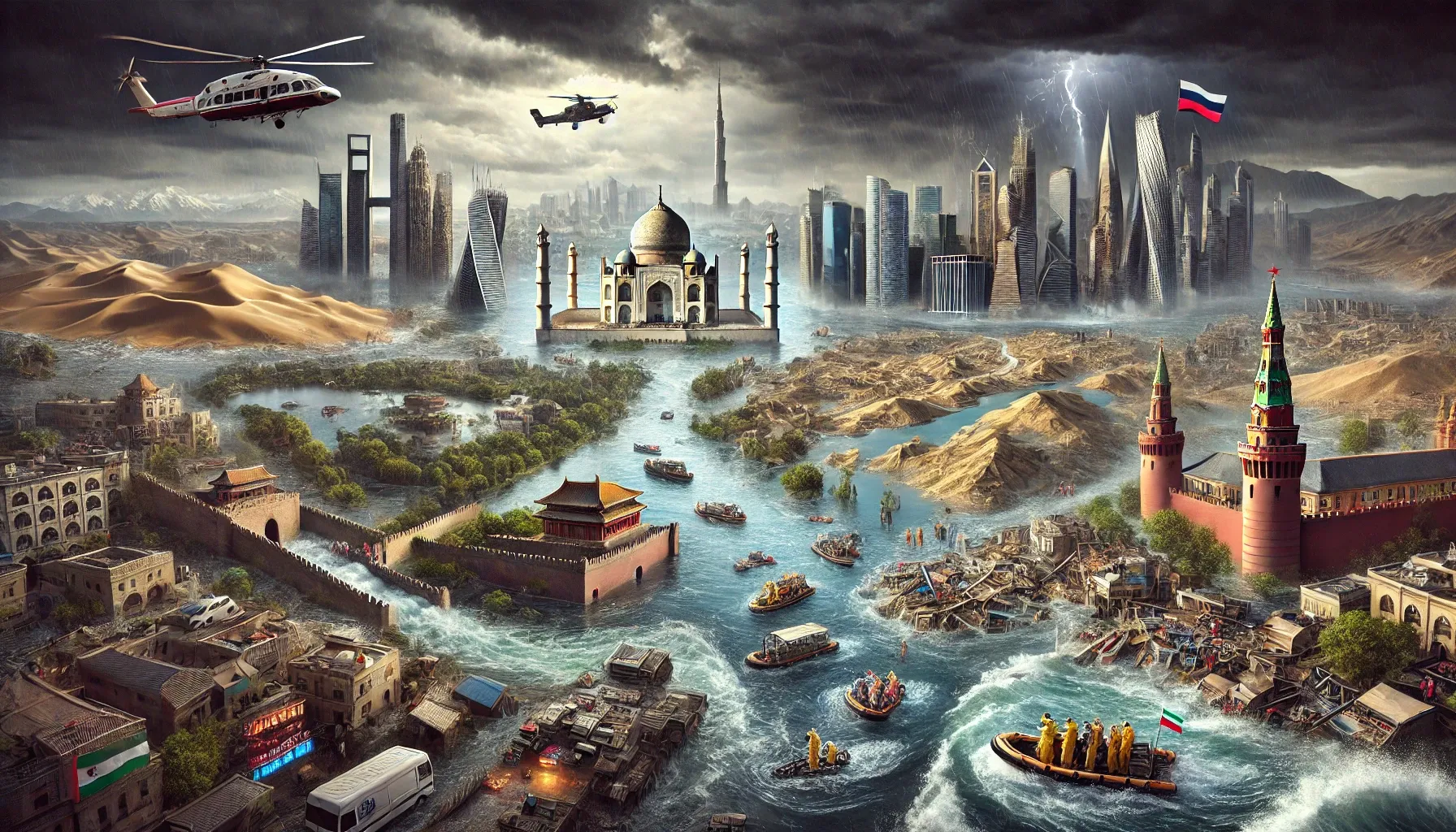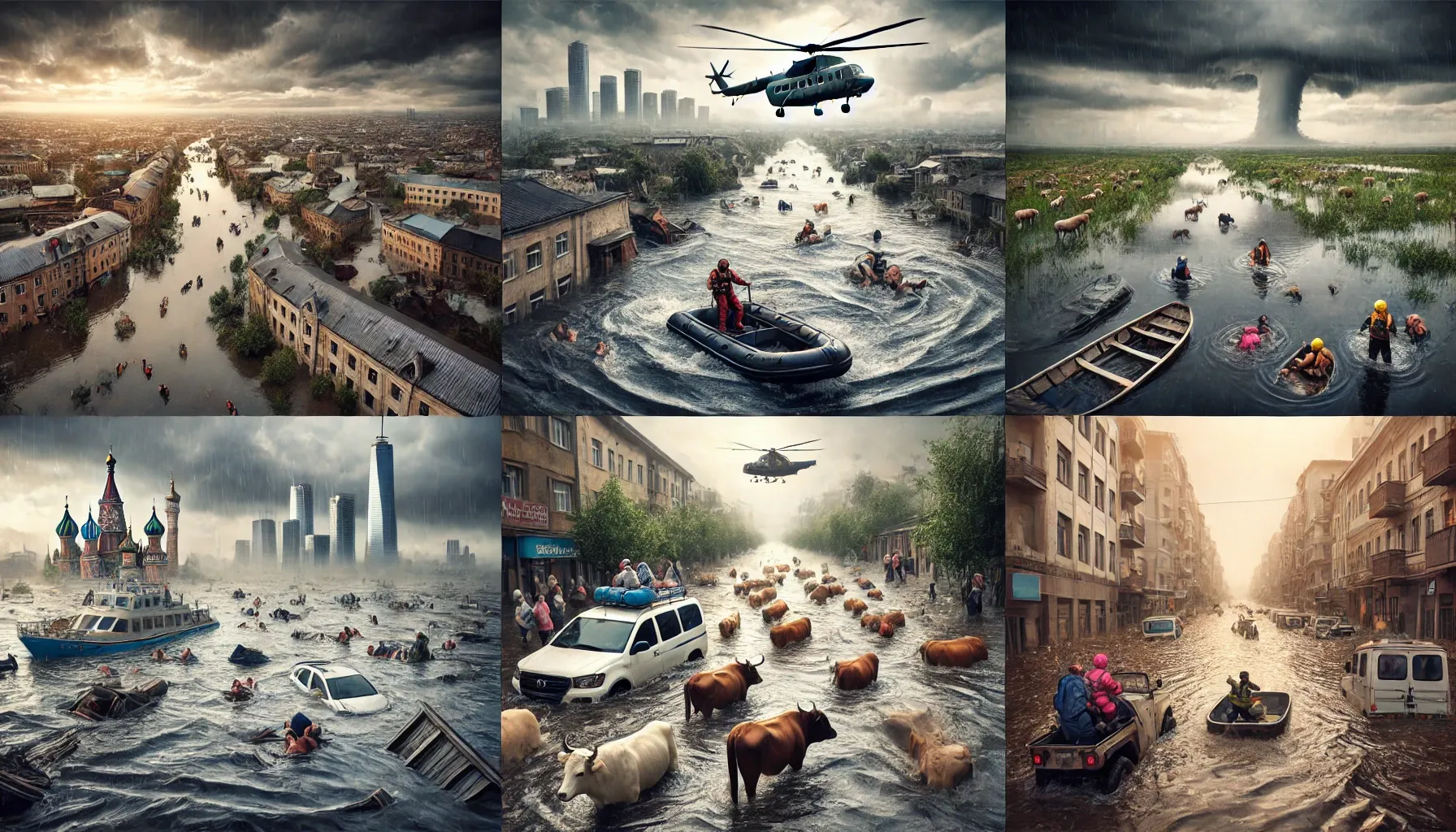What is known about floods around the world?

- Floods around the world: consequences in China, the UAE, and Oman
- Catastrophic floods in Russia and Kazakhstan
- Causes of floods and their consequences
- Floods in the world: a global threat
- Disaster: floods and how to behave
Floods around the world
In recent years, frequent floods have been observed in various parts of the world. After countries with high precipitation, such as Russia and the UAE, Guangdong province in China faced devastating floods that claimed lives and affected more than 110,000 people. The water level in the Bei River, a tributary of the Pearl River, reached historic highs, and total rainfall for April set new records in several areas.
Implications in China
Four people have died, and ten are still missing in the cities of Shaoguan and Qingyuan. Large-scale rescue operations are underway using helicopters and rubber boats to evacuate stranded residents. The infrastructure is suffering from severe damage, transportation networks are disrupted, leading to evacuations and significant losses for local residents and businesses. Avalanches have destroyed communication and internet services, complicating rescue efforts and isolating some areas.
Actions in the UAE and Oman
Heavy rains also occurred in Dubai and Oman. In the UAE, April 2024 was marked by widespread flooding that claimed the lives of four people. Streets were flooded, including sewage, which posed a threat to public health. Several thousand volunteers came to assist the victims, and the government developed an emergency response strategy for future crises.
The situation in Oman
In Oman, the death toll from the floods has reached at least 19.
Floods in Russia and Kazakhstan
In April 2024, powerful floods occurred in Russia and Kazakhstan, severely affecting the Ural and Siberia regions. The cause of the natural disaster was the sudden melting of ice due to spring flooding, which led to rising water levels in the rivers. One of the most severe situations was in Orenburg after the dam on the Ural River broke in Orsk. This became the most significant flood in the history of observations in this region.
Floods in Kazakhstan
Kazakhstan has faced one of the most devastating floods in the last 80 years. More than 3,400 residential homes have been flooded, and a state of emergency has been declared in ten regions. Images are provided by Roscosmos and Sergei Medvedev / TASS / DPA / Picture Alliance.
Floods in Libya
Let's move on to Libya. The catastrophic floods in this country were caused by the storm "Daniel," which hit the region on September 9, 2023. Heavy rains and breached dams led to widespread destruction. The city of Derna in northeastern Libya was particularly affected, where the waters swept away several major bridges and high-rise buildings.
The consequences of the floods in Libya
- Satellite images showed that entire neighborhoods were destroyed, and many bodies were swept out to sea.
- The number of fatalities has exceeded 6,000, and more than 10,000 people are reported missing.
- Hospitals are destroyed, morgues are overflowing. Humanitarian aid has been sent to affected areas, with estimates of up to 1.8 million people affected by the heavy rain.
Causes of floods
Why do floods occur? They can be caused by heavy rains, melting snow after a cold winter, or storm surges, which lead to water overflow and flooding.

Causes of floods
When a hurricane, typhoon, or tropical storm approaches, areas located near water are at risk of flooding due to storm surges. These natural disasters can inundate coastal regions, pushing large amounts of water inland, putting settlements and agricultural lands at risk. Sudden floods are equally dangerous for both people and infrastructure, as they often occur as a result of heavy rainfall over a short period of time. The occurrence of such floods can be linked to steep terrain, poor drainage systems, and wildfires that have degraded the soil and vegetation cover.
Other reasons and consequences
Wintertime can also lead to massive flooding, due to the formation of ice jams on rivers in cold climates.
29 January
9 October 2024
9 October 2024
29 September

Climate change
Climate change can exacerbate the flooding problem by altering weather patterns and increasing the frequency and intensity of extreme events such as heavy rainfall and hurricanes.
Countries prone to flooding
It is difficult to identify the countries most prone to floods, as floods can occur in different forms and with different frequencies. Nevertheless, some countries are particularly prone to flooding because of their geographical and climatic specificities. For example, Bangladesh is often cited as one of the most flood-prone countries in the world. This country is at risk of frequent and severe flooding due to its unique geographical location and monsoon climate. Bangladesh is crossed by many rivers, including the Ganges and the Brahmaputra, which carry water from the Himalayas.
The monsoon season, heavy rains, and melting snow in the mountains lead to a significant increase in water volume in rivers around the world. India faces the risk of coastal and river flooding, especially in the basins of the Ganges and Brahmaputra rivers, as well as on the eastern and western coasts due to cyclone activity.
Floods in Asian countries
In Vietnam, in the Mekong River delta, typhoons, heavy rainfall, and rising sea levels lead to regular river and coastal flooding. Indonesia is also vulnerable to natural disasters such as flash floods and river flooding, especially in Jakarta.
Intense rains in China
China is severely affected by riverine and flash floods caused by intense rainfall and snowmelt, particularly in the Yangtze and Yellow Rivers, as well as in southern provinces. Pakistan also regularly faces the risk of river flooding, particularly in areas near the Indus River due to heavy monsoon rains and snowmelt.
Floods in different countries around the world
- The Philippines is prone to coastal flooding from typhoons and flash floods due to heavy rains during the wet season.
- Nepal has a high risk of river flooding due to its mountainous terrain and heavy rains during the monsoon season.
- In the United States, especially along the Mississippi and Missouri rivers, significant river flooding often occurs due to various factors, including heavy rainfall, snowmelt, and dam failures.
- Libya, although it has a dry desert climate with low rainfall, is still prone to temporary flash flooding along the Mediterranean coast and in the northern part of the country due to irregular rainfall.
- Some areas have poor drainage systems, which exacerbates the problem and prevents the soil from absorbing water quickly.
In various corners of cities, inadequate drainage systems can exacerbate the effects of heavy rains, leading to local flooding. The topographical features in some areas, such as Jebel Akhdar in Libya, can cause sudden floods when water rushes down from the mountains into the valleys. One of the most devastating floods in history occurred in 1931 in China. The Yangtze and Huai River basins were particularly affected due to prolonged and heavy monsoon rains, snowmelt in the mountains, and rivers overflowing their banks. Estimates of the death toll from this natural disaster range from 1 to 4 million people, with millions forced to leave their homes. The flood caused immense suffering, including famine and the spread of diseases among survivors. Many agricultural lands were submerged, leading to crop losses and food shortages. Residential homes, infrastructure, and transportation routes were severely damaged or completely destroyed.
In the event of being in a flood zone, it is essential to immediately follow evacuation instructions. If you cannot leave the area and are trapped in a building, it is recommended to go to the highest floor or the roof, taking necessary items and documents with you. Do not attempt to walk, swim, or drive through flooded areas, as even a small current can knock you off your feet, and a water depth of one foot can sweep your vehicle away. Avoid contact with floodwaters, as they may be contaminated with sewage, chemicals, or debris. Keep an eye on weather forecasts from local authorities, meteorological services, or news sources, and pay attention to flood warnings and alerts. If you find yourself in a vehicle that is stuck in fast-moving water, stay in the car.
Conclusion
As a witness to the recent catastrophic floods affecting many regions around the world, I cannot help but notice the increasing frequency and destructiveness of such natural disasters.From the province of Guangdong in China to the deserts of Oman, from the lands of Russia to the bays of the UAE, floods are causing suffering and loss of life.
As we observe the effects of these disasters, we see infrastructure destruction, population evacuations, and severe property losses.Heavy rains are causing landslides, disruptions in the transportation network, and other difficulties, making rescue operations more challenging.
However, it is important to note that in each case, the community showed solidarity and actively participated in helping those affected.Volunteers, government agencies, and initiative groups - all of them fought against adversity side by side.
The sad statistics of victims and missing persons cannot leave anyone indifferent.With this in mind, we must not only respond to the aftermath, but also be more responsible in protecting the environment to reduce the likelihood of similar disasters in the future.
Such a variety of causes for flooding, from heavy rains to snowmelt, prompts reflection on the ecological sustainability of our way of life.May these sorrowful events serve as a lesson for us in preserving our planet for future generations.
Comment
Popular Posts
9 October 2024
1485
9 October 2024
9940
29 September
386
Popular Offers

Subscribe to the newsletter from Hatamatata.com!
Subscribe to the newsletter from Hatamatata.com!
I agree to the processing of personal data and confidentiality rules of Hatamatata











